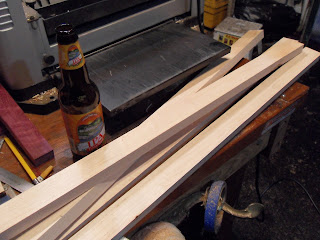to me making a guitar or stringed instrument is an exercise in transferring and amplifying the vibration from the strings to the hollow box, in this case a cigar box. for starters if I'm gonna make the box resonate, it needs to be hollow. This means the neck needs to end at the box and then I need to brace the box minimally but in such a way that it will stand up to the string tension but be able to vibrate freely. I'm getting ahead of myself and we'll cover this later when we need to, so for now we will concentrate on building the neck.
I have built a few guittys and have come up with some standards for the necks I want to use. I have decided that I will be making four string guitars and have come up with a good string spacing of .350". Four strings allows me to have a playable neck width that doesn't need any truss rod which means less work for me and you. I have decided on a 24" fret scale simply because they play well and use less tension which means less neck deflection and frankly you need to start somewhere.
I will be using Hard maple for the neck and some purple heart for the fretboard. I purchased a piece of 1" by 7" hard maple from a local lumber supplier and the purple heart online. The purple heart was approx 1" by 7".
This post deals with ripping and planing the wood we need to get started. first I started by planing the hard maple from 1" down to .750". I planed it at first crown side up and then flipped it and ran it through until I got my desired thickness of .750". I use dial calipers for good measure.
After I get the thickness I need I mark the boards to get four necks at a width of 1.5" which will be then planed down to 1.35" which is four strings @ .350" with .15 on either side to reach the side of the fretboard. I then set up my band saw and clamped on a quick guide using a speed square, two quick clamps and a ruler with decimal inch graduations to get the guide good and square and at the right measurement from the blade.
next I run the necks through four at a time and plane them down to 1.35" plus maybe .005" for sanding purposes. the pic shows me only doing one at a time but i ran them through four at a time to insure accuracy and speed things up.
Now that I have my neck blanks I need to rip and plane the fretboard wood, so I mark and rip the purpleheart and then plane it to .250". You can make it thinner but I like .250" so there.
I also ripped some maple to the same width but planed it to .5" to make the headstock and ears that we'll get into later.
In these pics you'll see four neck blanks, two fretboard blanks, two headstock blanks that will be cut into 6" pieces, and a piece of cocobolo. I figure if I am going to make a neck I might as well make four.
It might be a good time to mention that when you plane your neck blanks, you need to leave extra room on the ends for the portion that gets screwed up in the planer. So find your length and add 6" if you have a similar planer.
before we glue the fretboard we need to make few cuts on the maple blank to accommodate the soundboard and then we're in business. we will cover that in the next post.








No comments:
Post a Comment